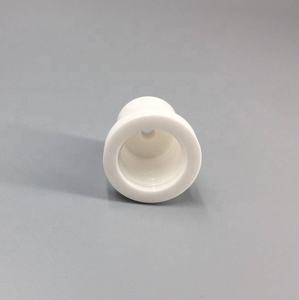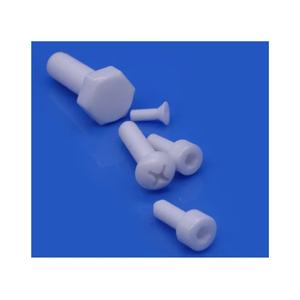1. Material Basics and Microstructural Style
1.1 Make-up and Crystallographic Security of Alumina
(Alumina Ceramic Nozzles)
Alumina (Al ₂ O SIX), specifically in its alpha stage, is a completely oxidized ceramic with a corundum-type hexagonal close-packed structure, providing remarkable thermal stability, chemical inertness, and mechanical strength at raised temperature levels.
High-purity alumina (normally 95– 99.9% Al Two O ₃) is liked for nozzle applications as a result of its marginal contamination web content, which minimizes grain border weakening and enhances resistance to thermal and chemical destruction.
The microstructure, containing penalty, equiaxed grains, is engineered throughout sintering to lessen porosity and make best use of thickness, straight affecting the nozzle’s disintegration resistance and architectural honesty under high-velocity liquid flow.
Additives such as MgO are often presented in trace total up to prevent abnormal grain development throughout sintering, ensuring an uniform microstructure that supports lasting dependability.
1.2 Mechanical and Thermal Features Relevant to Nozzle Performance
Alumina porcelains show a Vickers hardness exceeding 1800 HV, making them highly resistant to abrasive wear from particulate-laden fluids, a vital characteristic in applications such as sandblasting and unpleasant waterjet cutting.
With a flexural strength of 300– 500 MPa and a compressive stamina over 2 GPa, alumina nozzles maintain dimensional security under high-pressure procedure, typically ranging from 100 to 400 MPa in commercial systems.
Thermally, alumina retains its mechanical residential or commercial properties up to 1600 ° C, with a low thermal development coefficient (~ 8 × 10 ⁻⁶/ K) that supplies outstanding resistance to thermal shock– essential when exposed to rapid temperature changes during start-up or shutdown cycles.
Its thermal conductivity (~ 30 W/m · K) suffices to dissipate local heat without causing thermal slopes that can result in cracking, stabilizing insulation and heat management demands.
2. Production Processes and Geometric Accuracy
2.1 Forming and Sintering Methods for Nozzle Construction
The production of alumina ceramic nozzles starts with high-purity alumina powder, which is processed into a green body using approaches such as cold isostatic pressing (CIP), injection molding, or extrusion, depending on the desired geometry and set size.
( Alumina Ceramic Nozzles)
Cold isostatic pressing applies consistent stress from all directions, producing an uniform density circulation essential for decreasing flaws during sintering.
Shot molding is utilized for complicated nozzle shapes with inner tapers and fine orifices, permitting high dimensional precision and reproducibility in mass production.
After shaping, the environment-friendly compacts go through a two-stage thermal treatment: debinding to remove organic binders and sintering at temperature levels in between 1500 ° C and 1650 ° C to achieve near-theoretical density with solid-state diffusion.
Specific control of sintering atmosphere and heating/cooling prices is necessary to prevent warping, cracking, or grain coarsening that can endanger nozzle performance.
2.2 Machining, Sprucing Up, and Quality Assurance
Post-sintering, alumina nozzles frequently need accuracy machining to attain limited resistances, especially in the orifice region where flow characteristics are most sensitive to surface area finish and geometry.
Diamond grinding and lapping are used to improve interior and outside surface areas, attaining surface area roughness worths below 0.1 µm, which reduces circulation resistance and stops fragment buildup.
The orifice, typically varying from 0.3 to 3.0 mm in size, should be free of micro-cracks and chamfers to ensure laminar circulation and regular spray patterns.
Non-destructive testing methods such as optical microscopy, X-ray evaluation, and pressure cycling examinations are employed to validate architectural honesty and performance uniformity prior to deployment.
Custom-made geometries, including convergent-divergent (de Laval) profiles for supersonic circulation or multi-hole varieties for follower spray patterns, are increasingly fabricated making use of innovative tooling and computer-aided layout (CAD)-driven manufacturing.
3. Practical Benefits Over Different Nozzle Materials
3.1 Superior Disintegration and Rust Resistance
Contrasted to metal (e.g., tungsten carbide, stainless steel) or polymer nozzles, alumina shows much greater resistance to unpleasant wear, particularly in environments involving silica sand, garnet, or other hard abrasives used in surface area preparation and cutting.
Steel nozzles degrade quickly because of micro-fracturing and plastic deformation, needing frequent substitute, whereas alumina nozzles can last 3– 5 times longer, significantly decreasing downtime and operational costs.
Furthermore, alumina is inert to a lot of acids, antacid, and solvents, making it ideal for chemical spraying, etching, and cleaning procedures where metal elements would wear away or pollute the liquid.
This chemical stability is specifically beneficial in semiconductor production, pharmaceutical processing, and food-grade applications needing high pureness.
3.2 Thermal and Electric Insulation Residence
Alumina’s high electrical resistivity (> 10 ¹⁴ Ω · centimeters) makes it suitable for usage in electrostatic spray finish systems, where it stops fee leak and ensures uniform paint atomization.
Its thermal insulation capability enables risk-free operation in high-temperature splashing environments, such as flame splashing or thermal cleaning, without warm transfer to surrounding elements.
Unlike steels, alumina does not catalyze undesirable chain reaction in reactive liquid streams, preserving the stability of delicate solutions.
4. Industrial Applications and Technological Impact
4.1 Duties in Abrasive Jet Machining and Surface Therapy
Alumina ceramic nozzles are important in rough blasting systems for corrosion removal, paint stripping, and surface texturing in automotive, aerospace, and building and construction sectors.
Their capability to keep a constant orifice size over expanded use makes certain consistent abrasive speed and impact angle, directly affecting surface coating quality and procedure repeatability.
In rough waterjet cutting, alumina concentrating tubes lead the high-pressure water-abrasive mix, enduring abrasive forces that would rapidly degrade softer products.
4.2 Use in Additive Production, Spray Coating, and Liquid Control
In thermal spray systems, such as plasma and fire spraying, alumina nozzles direct high-temperature gas flows and molten particles onto substratums, taking advantage of their thermal shock resistance and dimensional stability.
They are likewise used in precision spray nozzles for farming chemicals, inkjet systems, and fuel atomization, where wear resistance makes sure lasting application accuracy.
In 3D printing, specifically in binder jetting and product extrusion, alumina nozzles provide great powders or thick pastes with very little obstructing or use.
Emerging applications include microfluidic systems and lab-on-a-chip tools, where miniaturized alumina parts supply resilience and biocompatibility.
In summary, alumina ceramic nozzles stand for an important junction of materials scientific research and industrial engineering.
Their exceptional mix of hardness, thermal stability, and chemical resistance allows reputable performance in some of one of the most demanding fluid handling environments.
As industrial procedures press toward greater pressures, finer tolerances, and much longer solution intervals, alumina porcelains remain to set the criterion for sturdy, high-precision circulation control elements.
5. Supplier
Alumina Technology Co., Ltd focus on the research and development, production and sales of aluminum oxide powder, aluminum oxide products, aluminum oxide crucible, etc., serving the electronics, ceramics, chemical and other industries. Since its establishment in 2005, the company has been committed to providing customers with the best products and services. If you are looking for high quality hydrated alumina, please feel free to contact us. (nanotrun@yahoo.com)
Tags: Alumina Ceramic Nozzles, Ceramic Nozzles, Alumina Nozzles
All articles and pictures are from the Internet. If there are any copyright issues, please contact us in time to delete.
Inquiry us

